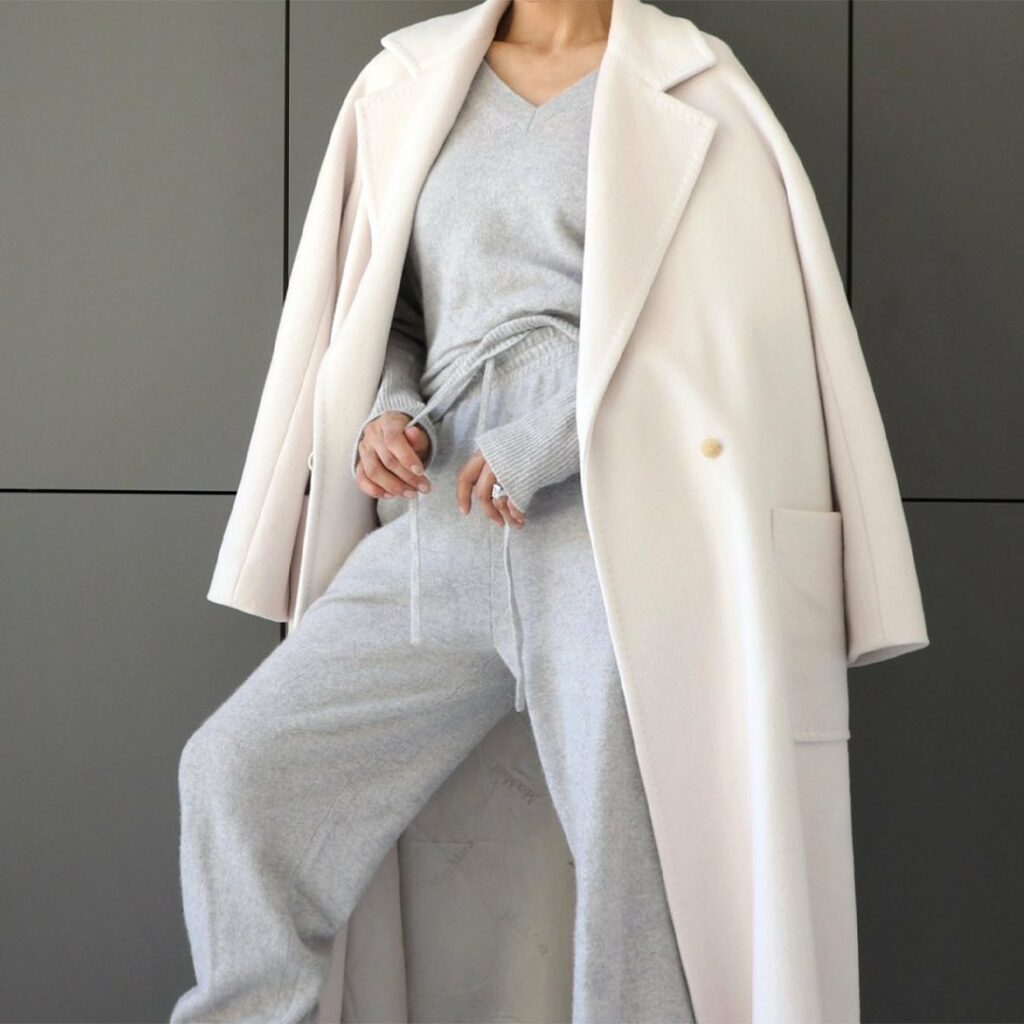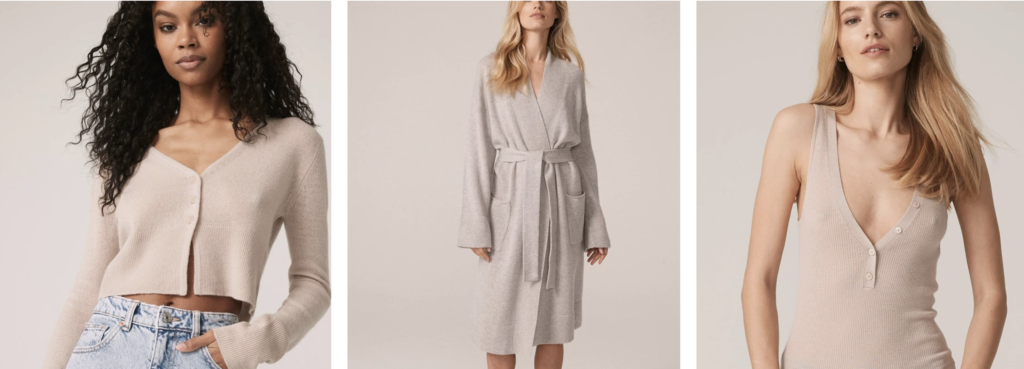Cashmere is one of the most luxurious fibers in the world. It is a natural fiber derived from goats (not sheep) and is three times as insulating as sheep wool.
The softness, elegance, and class associated with cashmere has long been reserved for high-end brands selling cashmere products (sweaters, shawls, gloves, etc.) for at least over $300.
However, the pace of production and consumption of cashmere has changed since the millenia – with cheap appearances in fast fashion brands, like Uniqlo, and worsening environmental impacts due to high demand and lower prices of the raw material.
So, what is cashmere? What exactly brings it into these perilous conditions? How do you tell if cashmere is sustainable, ethical, and high quality? Read on to explore these questions, plus everything else you need to know about this fabric.
What is Cashmere?
Qualities
Cashmere is a soft and strong luxury fabric. It is warm for winter (three times more insulating than sheep’s wool) and cool in the heat due to its lightweight and comfortable quality.
It’s also a versatile fabric that can be made into clothing (jackets, sweaters, cardigans), accessories (gloves, scarves), and home goods (blankets).
Cashmere must be properly cared for if you want them to last a long time (including washing – read our guide for washing cashmere garments).
If you can take care of them, these garments may be worth the pricey investment as they will remain durable and soft for years. It is recommended to professionally dry clean cashmere. However, at home, the best option may be to hand wash it with a delicate detergent in lukewarm water and lay flat to dry.
Origins
Production of cashmere has existed for thousands of years. It was originally produced in the 13th century in Kashmir, which is an Indian region where cashmere derives its name.
Between the 16th and 19th centuries, cashmere was used as a luxurious fiber for shawls by Indian and Iranian emperors for political and religious ceremonies. Then, through East-West explorations and trade over hundreds of years, it became famous. Europeans started to significantly import cashmere in the 18th century, notably to Scotland and France.
Where Does Cashmere Come From?
Cashmere comes from goats, most often the cashmere (aka Kashmir) or pashmina goat.
The fiber can be derived from any type of goat if the hairs are fine enough to be cut, but higher quality cashmere grows on herds along the Himalayas.
These herds are often found in Mongolia, China, northern India, and Iran. This is because the seasonal changes here lead to optimal growth for cashmere, since colder winters cause goats to grow super soft, long, and fine hairs to keep them warm. These features are important because cashmere quality is based on its fineness and length.
How Cashmere is Produced
A main reason why cashmere is so expensive is the reality of limited raw materials and intensive manufacturing.
To produce one sweater, it takes about four goats. On top of this, there is only one yield time per year, since the moulting season (when goats naturally shed their fur in warmer weather) is March to May.
Basically, the goats shed two layers: coarse hair and a soft, fine undercoat. Obviously, the soft undercoat is desired.
Therefore, farmers usually comb the hair to separate the coarse from fine hair. If they shear the goat, there is more dehairing to do later for separating the less from more coarse hairs. Lower quality cashmere has more of the rough overcoat and longer fibers, which is why it is more vulnerable to pilling.
Next, the fibers are shipped to factories to be cleaned, dyed, and spun into yarn. The softness of cashmere makes it a delicate fiber to manufacture, so producers must not use harsh chemicals or overprocess the fibers. Then, the fabrics are shipped to companies.
The quality of cashmere products are based on the fineness and length of hairs, with even low-grade cashmere being at least twice the price of wool.
Is Cashmere Sustainable?
Next, let’s analyze concerns involving ethics and sustainability.
Land and Labor Practices
Because goats supply their coats to make cashmere, there are concerns about animal welfare.
Ethical implications have been strained over the past decade. Coupled with an increase in demand and keeping pace with low prices, farmers increase their herd size to produce enough material. This leads to issues with overpopulation. Additionally, farmers may shear the goats too early, causing goats to freeze since they have little fat to them keep warm in the winter.
Land degradation is also a result of overpopulation of goat herds, turning once green grasslands into deserts. Larger herds mean more mouths to feed, and sharp hooves break up the formerly unspoilt soil.
With climate changes, seasons are more extreme. Winters are very harsh followed by summer droughts, so goat herds are dying. In response, farmers breed more goats, which fuels the cycle of overpopulation and land degradation.
Overall, current farming practices like this are unsustainable in the long term, triggering environmental consequences such as regional ecological imbalances, like air pollution.
Also, social problems arise through the stress on farmers due to economic insecurity, harder livelihoods, and faltering labor and animal welfare.
Improvements
Leading sustainability brands like Patagonia and Stella McCartney, as well as brands like Riley Studio and Naked Cashmere, work with recycled cashmere instead of virgin cashmere.
However, eliminating virgin cashmere altogether is not the main issue. The overall farming and production needs to be done in a more responsible way.
To achieve this goal, organizations like the Sustainable Fiber Alliance “encourage the adoption of responsible production practices that minimise environmental impact, safeguard herder livelihoods and meet high animal welfare standards.”
They have partnered with numerous brands, with major players like Burberry and major Scottish cashmere producer Johnstons of Elgin, as pioneer members.
SFA certified fiber has been traced from herders to the final product and was assessed against the Animal Husbandry Code of Practice, the Rangeland Stewardship Code of Practice, and Clean Fibre Code of Practice.
Bottom Line
If you’re looking for a luxurious and soft fabric that can be both warm and lightweight, cashmere is the way to go. Just be conscious of the brand’s supply chain transparency and price. If it’s too cheap to believe, the fabric is probably low quality and/or attained through suspect labor. Two specific labels to look for are recycled cashmere, cruelty free, and SFA-certified cashmere.
If you want to shop for high-quality sustainable cashmere garments, here are some top brands:
- Naked Cashmere
- NAADAM
- Stella McCartney
- Patagonia
- Reformation
- The RealReal (for secondhand shopping)
UP NEXT: What is Tencel and Is It as Sustainable as They Say?


